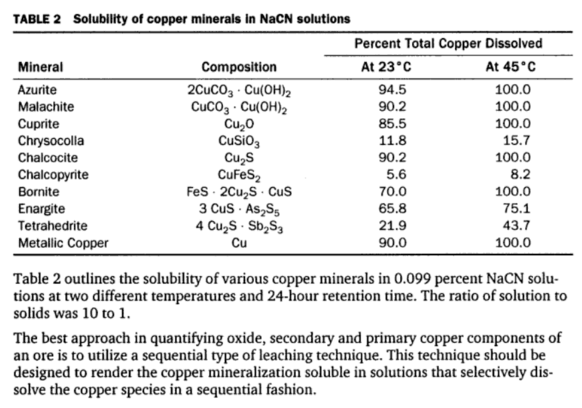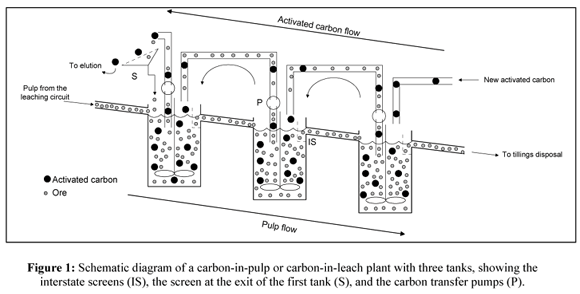Effect of Gold Particle Size on Rate of Dissolution

When coarse free gold occurs in ores, the usual practice is to remove it by means of gold traps, jigs, blankets, etc. ahead of cyanidation. Otherwise, these coarse particles might not be completely dissolved in the time available for cyanidation. Another practice which reduces the size of the gold particles going to cyanidation is the […]
Gold & Silver Dissolution and Cyanide Concentration

By far the most important cyanides used in cyanidation are sodium cyanide and calcium cyanide. The latter product is sold in an impure form analyzing close to 50% NaCN equivalent. The former is sold in various grades from 85 to 98% NaCN. In comparing the dissolving effects of the cyanides of ammonium, sodium, potassium, magnesium, […]
Arsenic and Antimony Sulphide Minerals in Cyanidation

The successful cyanidation of gold ores containing appreciable amounts of arsenic or antimony sulphide minerals such as orpiment, realgar, and stibnite is usually difficult or even impossible. Extractions are low and the solutions soon become ‘foul.’ The gold in such ores could be free and uncoated, and no trouble in dissolving it in clean cyanide […]
How Copper Affects Cyanidation & Leaching

Many precious metal ores contain copper minerals in various amounts. These copper minerals dissolve in cyanide solutions to a greater or lesser degree depending on the particular copper mineral or minerals present, their fineness, and the dissolving effect of the cyanide solutions. In the process of dissolution the copper combines with, or as it is […]
Process of Cyanide Gold Extraction

Here I present an Process EXAMPLE of Gold Extraction Cyanide in which the cyanidation feed consists of a pyrite concentrate floated after the selective flotation of a copper-gold concentrate. The pyrite concentrate is reground to 90% minus 325 mesh and aerated in a high-lime solution prior to cyanidation. It contains 99% sulphides of which 10 to […]
Refractory Gold Processes

Gold can be leached and extracted/recovered in several ways. Even if you gold is “refractory” in pyrite or arsenopyrite, you can still get much value from your ore/rock depending on the economics of capital and operating cost. The cheapest and fastest option is to simply grind and CIL the whole thing according the the process […]
Gold CIL & CIP Gold Leaching Process Explained CCD

Cyanide is a lixiviant, or reagent that is used to leach, often in tanks, gold from a solid matrix and form a gold cyanide complex. The gold cyanide complex is then extracted from the pulp or slurry by adsorption onto activated carbon. CIL stands for carbon-in-leach. This is a gold extraction process called cyanidation where […]
